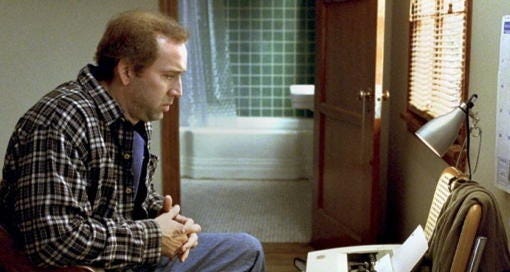The Trouble with Internal Monologues
That Little Voice Inside Your Head That Says, “Don’t tell your reader what the characters are thinking.”
Like any creative endeavor, screenwriting is filled with rules that many successful creators ignore with impunity.
First among these is “Don’t Do Voice-Over’s!” You may have heard this advice given by screenwriting guru Robert McKee in the movie ADAPTATION, at which point the constant voice-over by protagonist/screenwriter/fake twin Charlie Kauffman cuts off mid-sentence and vanishes from the film. (I see what you did there, Charlie.)
As someone who has been both a student and instructor in many, many screenwriting classes, I can assure you, voice-overs are a frequent topic of debate. Any list of your favorite movies, there’s a good chance some of them have voice-over. If those fancy-pants writers can use it, why can’t I?
Well, I have also been a script reader. From that experience, I have come to believe those “rules” scoffed at by the pros (and aspiring pros) probably came into being because readers, agents, producers and executives became so fed up with seeing it done poorly (usually as a crutch to prop up lazy writing) that they threw up their collective hands and said, “I don’t care if Goodfellas did it. The next script with voice-over is getting thrown straight into the shredder!”
(An interesting corollary from the world of kidlit: Rhyming picture books are always popular sellers. Yet many agents, even those who represent rhyming picture book authors, refuse to read any submission with rhyme. It seems absurd, until you read a manuscript full of shaky meter and forced rhymes. Then you totally get it.)
I’ve had some students who are of the opinion that you’re not allowed to use voice-over until you’re established, but after that, go nuts! As if one needed permission from the WGA before typing the words (V.O.)
But that’s not quite right. “Art is anything you can get away with.” A quote attributed to Marshall McLuhan, Andy Warhol and Terrence Trent D’Arby. (It’s probably McLuhan but man, would I love it if it was by my fellow Andy.) Writers can always get away with voice over if it adds to the story, but just because one person does it well, does not give everyone else an excuse to do it poorly.
Why am I telling you this? Having read lots of (and, if I’m being honest, probably written) bad voice over, I have a Pavlovian aversion to it, but now I’m doing comics. Specifically, adapting an old SciFi script of mine into a serialized story for a comic anthology I’m editing. (Still in preliminary stages, so don’t be impressed yet.)
Comics don’t seem to have the same stricture against... well, I guess you can’t call it voice-over. Let’s say internal monologue. I think historically comic book characters could have dialogue balloons or thought balloons. It was just a change in the balloon shape, not quite the same leap from from diegetic to non-diegetic sound.
Weirdly, though, while comics are still chock full of characters’ thoughts and internal monologues, you almost never seen thought balloons anymore. Maybe thought balloons are what that character is thinking in that moment. Thoughts in captions (which is the standard now) have a little more leeway. Maybe it’s an immediate thought, or maybe it’s the character reflecting on this moment from some future vantage point, or some mix of the two. Whatever serves the story best.
But I digress. My point is I have an 8-page part one that needs to do a lot of world building. Right now, I confess it’s a confusing mess. It needs desperate needs some internal monologue to let the reader know what’s going on.
I’m reassured here by the fact that one of my favorite comics (and inspiration for my other Kickstarter) Kurt Busiek’s ASTRO CITY, uses constant internal monologue. It’s practically hardwired into the DNA of the series. Astro City takes all the usual superhero tropes (Supervillains, teen sidekicks, alien invasion) and plays them completely straight but imbues them with surprising depth and pathos. To do that, we need insight into the interior lives of the characters, and interior monologue is a powerful and efficient way to do that, at least in the hands of a master like Busiek.
My hands, however, are not so masterful, and I’ve got a main character who is incredibly resistant to self-reflection. (Hmm, I wonder if some external crisis will force him to finally take a good look at himself and his life choices. 🤷♂️🤷♂️🤷♂️) So, any internal monologue coming from him just seemed fake and forced.
Luckily, there is an antagonist. He hates my protagonist’s guts, and my protagonist doesn’t even know he exists. Chances are this antagonist would be keeping tabs on the main character, and would have plenty of opinions about it.
So, that’s what I’m doing know. Sure, it’s tough going against my screenwriter instincts. (What a pity, too. The other parts of writing are soooo easy. 🙄) But it’s also fun. I don’t think I’ve ever read a story (comic book or otherwise) where the narrator is openly sneering and disdainful of the hero. And bonus, it’s good to have mysteries in a serialized story. My hope is readers will want to keep reading just so they can find out who’s telling this story, and why does he hate our hero so much?
How about you? Anyone out there have a tale of especially awful or good Voice Over/Internal Monologues that they’ve encountered. Bonus points if it’s from your own writing.




